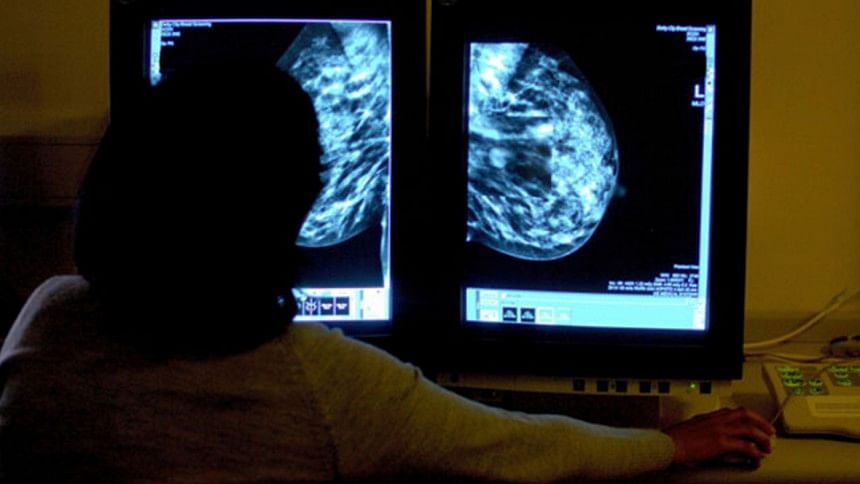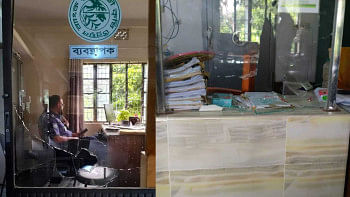The blind breast cancer detectors

Women being screened for breast cancer in Germany may find themselves in the hands of a blind examiner. The idea has been around for a few years, and unpublished research suggests that it really works - that blind people can in fact detect tumours earlier than their sighted counterparts.
Could blindness help detect breast cancer?
This surprising, yet simple idea came to a German doctor one morning while he was in the shower: would blind women actually do his job a lot better than he does?
"Three minutes is all the time I have to do clinical breast examinations in my practice," says Duisburg-based gynaecologist, Dr Frank Hoffmann.
"That's not enough time to find small lumps in the breast tissue, which is crucial to catching breast cancer early."
People trained to read Braille have a highly developed sense of touch, so Hoffmann guessed that blind and visually-impaired women would be better qualified than anyone else to carry out breast examinations on his patients.
The evidence is now unequivocal, he says.
In an as yet unpublished study carried out with Essen University, blind women are said to have detected nearly a third more lumps than regular gynaecologists.
"Women doing self-examinations can feel tumours which are 2cm and larger," Hoffmann says.
"Doctors usually find tumours between 1cm and 2cm, whereas blind examiners find lumps between 6mm and 8mm. That makes a real difference. That's the time it takes a tumour to spread its cells into the body."
In both Germany and the UK, regular mammograms and screening programmes are only offered to women aged 50 and over - but in both countries it is the biggest killer of women between 40 and 55, and in Germany the age of the women affected is falling.
Hoffmann says he founded his organisation, Discovering Hands, in order to save lives through early detection. He devised a course to train blind women to become Medical Tactile Examiners or MTEs, and there are now 17 working in practices across Germany.
One of them, Filiz Demir, sees about seven women a day, performing examinations which can last up to 45 minutes, which would be unheard of for a gynaecologist.
Just over a year ago Demir was working in a travel agency, but when she turned 35 her sight slowly deteriorated and it became harder and harder to do her job. She quit, retrained and learned Braille but found it impossible to even get invited for job interviews.
"Blindness was always my disability back then," she says.
"I could never work as fast as the others. I was always behind. Now my disability has become my strength. I'm not reliant on anyone and I can help others. It's a great feeling."
Curious to know how Demir and her colleagues work, I decided to have an examination myself.
Using strips of tape marked with co-ordinates in Braille, the MTE makes a grid on the breast. She slowly feels her way along this grid so that wherever she finds a lump she can tell the doctor its exact location.
Demir does an exhaustive examination, but the 30 minutes fly past. It's a calming, relaxed atmosphere, not at all uncomfortable and there's ample opportunity to ask questions.
After seven months in this practice, Demir's clearly relieved to have found mostly benign tumours. Just a few weeks back she found the first malignant one, which shook her a bit.
But it's my turn to be taken aback when she removes the Braille strips and cautiously tells me she's found something.
A lump on each side, in fact.
Had I been a regular patient in the practice, I would have gone into the next room for an ultrasound. Unfortunately, I have to take this information back to my gynaecologist in Berlin where I get a referral for an ultrasound and mammogram.
After a couple of weeks waiting for an appointment, the ultrasound finally shows up nothing. The radiologist tells me it doesn't make sense to do a mammogram - and unhelpfully suggests that the examiner probably just felt a bit of my ribs.
Hoffmann's advice in such a situation is to repeat the MTE check a few weeks later in the first half of the menstrual cycle. If a lump can still be detected by palpitation "a mammography makes sense", he says.
It's exactly this cycle of check-ups which can lead to false alarms, angst and harmful, unnecessary surgery, according to Prof Gerd Gigerenzer, director of the Max Planck Institute for Human Development.
"I know many women who have been frightened by false alarms. Some have a biopsy done, which showed nothing, but they live their lives from one mammogram to the next."
There's little consensus over the benefits of breast screening programmes and whether regular examinations actually save lives. Gigerenzer explicitly warns against them, and does not rejoice at the idea that it's now possible to detect smaller lumps.
"The finer and more precise the diagnostic techniques are, the more clinically irrelevant cancers will be detected," he says.
"This can lead to unnecessary surgery or radiation therapy. In this case, early detection only harms."
The jury, he says, is out on the Discovering Hands method until the team can provide the necessary evidence, proving whether their technique actually reduces mortality.
A study on this is expected to be completed and published later this year.
Meanwhile, one of Hoffmann's patients, Heike Gothe, tells me she owes her life to one of these examiners.
Still grappling with the shock of her husband's untimely death from illness, Gothe took up the helm of the family business, a successful small company exporting internationally. But it wasn't long before she received her own diagnosis.
"I had felt a lump on my right breast and went to see the doctor," Gothe says.
"They confirmed what I'd found and then detected a very small lump on the left, just 2mm in size. It didn't even show up on the ultrasound or mammogram, it was just the blind MTE who felt it."
Finding this remarkably small tumour may well have saved her life. Both tumours were diagnosed as malignant, but with chemotherapy and radiotherapy, she beat the cancer.
Gothe is a fighter but she puts her energy and positivity down to these intensive examinations by an MTE every six months. According to Gothe, that's why she can sleep at night and how she gets out to run her business.
"Fear rears its ugly head every now and then," Gothe says. "And the only way I can deal with it is that I know I'm in good hands."
A handful of German insurance companies are also convinced. Six of them now cover the costs for their patients to have these clinical breast examinations.
While new MTEs take up permanent positions in clinics across Germany and in Austria, the founder of Discovering Hands, Frank Hoffmann, is in talks with Israel and Colombia. He sees opportunities even further afield.
"I'm convinced," he says, "that especially in countries that aren't technically so advanced as Germany - this model could improve the quality of medical standards very dramatically."
Gerd Gigerenzer's test
In 2006 and 2007 Gigerenzer gave a series of statistics workshops to gynaecologists, and kicked off every session with the same question:
A 50-year-old woman, no symptoms, participates in routine mammography screening. She tests positive, is alarmed, and wants to know from you whether she has breast cancer for certain or what the chances are. Apart from the screening results, you know nothing else about this woman. How many women who test positive actually have breast cancer? What is the best answer?
- nine in 10
- eight in 10
- one in 10
- one in 100
Gigerenzer then supplied the doctors with data about Western women of this age. (His figures were based on US studies from the 1990s, rounded up or down for simplicity - recent stats from Britain's National Health Service are slightly different.)
- The probability that a woman has breast cancer is 1% ("prevalence"
- If a woman has breast cancer, the probability that she tests positive is 90% ("sensitivity")
- If a woman does not have breast cancer, the probability that she nevertheless tests positive is 9% ("false alarm rate")
In one session, almost half the gynaecologists said the woman's chance of having cancer was nine in 10. Only 21% said that the figure was one in 10 - which is the correct answer.

 For all latest news, follow The Daily Star's Google News channel.
For all latest news, follow The Daily Star's Google News channel. 



Comments